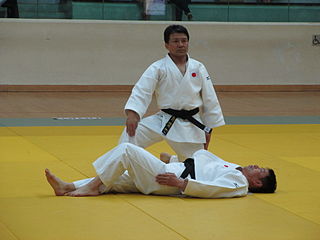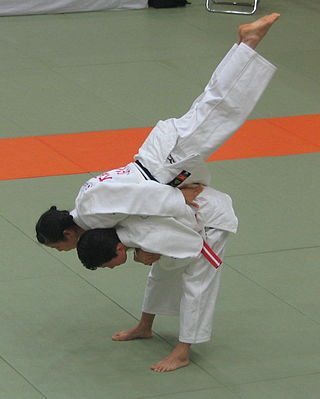
Judo is an unarmed modern Japanese martial art, Olympic sport, and the most prominent form of jacket wrestling competed internationally. Judo was created in 1882 by Kanō Jigorō as an eclectic martial art, distinguishing itself from its predecessors due to an emphasis on "randori" instead of "kata" alongside its removal of striking and weapon training elements. Judo rose to prominence for its dominance over established jujutsu schools in tournaments hosted by the Tokyo Metropolitan Police Department, resulting in its adoption as the department's primary martial art. A judo practitioner is called a "judoka", and the judo uniform is called "judogi".

Japanese martial arts refers to the variety of martial arts native to the country of Japan. At least three Japanese terms are used interchangeably with the English phrase Japanese martial arts.
Shuri-ryū (首里流) karate, is an eclectic martial arts system developed by Robert Trias (1923–1989), reportedly the first Hispanic to teach a form of karate in the mainland United States, who opened his public first dojo in 1946 in Phoenix, Arizona.
Tenjin Shinyo-ryu, meaning "Divine True Willow School", can be classified as a traditional school (koryū) of jujutsu. It was founded by Iso Mataemon Ryūkansai Minamoto no Masatari (磯又右衛門柳関斎源正足) in the 1830s. Its syllabus comprises atemi-waza, nage-waza, torae-waza and shime-waza. Once a very popular jujutsu system in Japan, among the famous students who studied the art were Kanō Jigorō, whose modern art of judo was greatly inspired by the Tenjin Shin'yō-ryū and Kitō-ryū.

Kata is a Japanese word meaning "form". It refers to a detailed choreographed pattern of martial arts movements made to be practised alone. It can also be reviewed within groups and in unison when training. It is practised in Japanese martial arts as a way to memorize and perfect the movements being executed. Korean martial arts with Japanese influence use the derived term hyeong and also the term pumsae.

Kata guruma (肩車) is one of the traditional forty throws of judo as developed by Kano Jigoro. Kata guruma belongs to the third group of the traditional throwing list in the Gokyo no waza of the Kodokan Judo. It is also part of the current 67 Throws of Kodokan Judo. Because the technique is not a sweep nor a trip and requires tori to pull uke into a carry, it is categorized as a hand throwing technique (tewaza).

Katame no Kata is one of the two Randori-no-kata of Kodokan Judo. It is intended as an illustration of the various concepts of katame-waza that exist in judo, and is used both as a training method and as a demonstration of understanding.

Ju no Kata is a kata in Judo. It is designed to teach the fundamental principles of judo, especially the principle of ju . It consists in three sets of techniques and is performed by a pair of people one acting as an Uke and the other a Tori. The kata can be performed without wearing a judogi and, as it doesn't involve the completion of any throws, does not need to be performed in a dojo.

Itsutsu-no-kata is a kata in Judo. It consists in five techniques, known only by their number. Although popular media generally claim that it was developed by Jigoro Kano, recent scientific research has conclusively shown that the kata predates the foundation of Kodokan judo and that Jigoro Kano took it from Tenjin Shinyō-ryū jujutsu and merely imported it into judo after he made minor amendments to it. The kata is considered unfinished. However, a completed performance version of the kata, expanded to ten techniques, was recently presented under the name Tō-no-kata. The techniques of Itsutsu-no-kata are composed of gentle movements evocative of natural forces.

Koshiki no Kata is a kata in Judo. It is also known as Kito-ryu no Kata (起倒流の形). It consists of 21 techniques originally belonging to the Takenaka-ha Kito School of jujutsu. Jigoro Kano revised the techniques and incorporated them into a kata in order to preserve the historical source of judo. The set of forms is antique and were intended for "Kumiuchi", the grappling of armored warriors in the feudal ages. As such, the kata is to be performed with both partners imagining that they are clad in armor. The Koshiki-no-kata, together with Nage-no-kata, Katame-no-kata, Ju-no-kata, Kime-no-kata and Goshin-Jitsu, is recognised by the International Judo Federation (IJF.) Although koshiki-no-kata is not often seen in the United States, it is still taught and practiced in Japan. Some striking demonstrations of it from the 1950s can be seen in the film "Classic Judo Kata," by Harold Sharp. If the description of the kata in that film is correct, it would be the only judo kata that involves attacking the cervical spine.

Kata-Gatame (肩固) is one of the seven mat holds, Osaekomi-waza, of Kodokan Judo. It is also one of the 25 techniques of Danzan Ryu's constriction arts, Shimete, list. In grappling terms, it is categorized as a side control hold. Primarily used as a hold down in Judo, it is mostly used as a choke in Jiu-Jitsu and mixed martial arts. WWE wrestler Braun Strowman and former Impact Wrestling Superstar, Samuel Shaw use this move as their finishing maneuver.

The ippon seoi nage (一本背負い投げ) is a throw in judo. It is a variant of Seoi nage, and is one of the nineteen accepted techniques in Shinmeisho No Waza of Kodokan Judo. It is classified as a hand throwing technique, or te-waza.

Tai sabaki (体捌き) is a term from Japanese martial arts and which relates to 'whole body movement', or repositioning. It can be translated as body-management. It is a term used widely in and very important in kendo, jujutsu, aikido, judo, karate and ninjutsu. Tai sabaki is usually used to avoid an attack, such that the receiver of the attack ends up in an advantageous position and it is often wrongly referred to as evasion.

Jigoro Kano was a Japanese educator, athlete, and the founder of Judo. Along with Ju-Jutsu, Judo was one of the first Japanese martial arts to gain widespread international recognition, and the first to become an official Olympic sport. Pedagogical innovations attributed to Kanō include the use of black and white belts, and the introduction of dan ranking to show the relative ranking among members of a martial art style. Well-known mottoes attributed to Kanō include "maximum efficiency with minimum effort" and "mutual welfare and benefit".
Gonosen-no-kata is a judo kata that focuses on counter-attacks to throwing techniques. It is not an officially recognized kata of judo, but its importance is attested to by its inclusion in Kawaishi's The complete seven katas of judo. Writing in the early post-war period, Kawaishi described the kata as being practiced less in Japan than in Europe.

Emily Diana Watts or Diana Watts or Mrs Roger Watts (1867–1968) was among the first female instructors of the Japanese art of jujitsu in the Western world. She was also an innovator in the field of physical culture.
Practice of Kaeshi no Kata is almost entirely limited to Great-Britain, where until today it has been understood as a judo kata which, like the Gonosen-no-kata, focuses on counter-attacks to throwing techniques. The kata was commonly explained as being an older form than Gonosen-no-kata, that was passed onto Ōtani Masutarō from Tani Yukio.
The Nage-waza ura-no-kata is a judo kata that, like the Gonosen-no-kata, focuses on counter-attacks to throwing techniques. It was developed by Mifune Kyūzō, and is not an officially recognized Kodokan kata.
The Katame-waza ura-no-kata is a judo kata that can be considered as a complement to Mifune Kyūzō's Nage-waza ura-no-kata, but that instead focuses on counter-attacks to controlling techniques rather than throwing techniques. It was compiled by Itō Kazuo from techniques developed by other Japanese newaza experts, and is not an officially recognized Kodokan kata.













